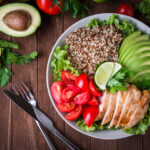
Healthy eating can be confusing. We all have different requirements and food preferences, not to mention time, money and interest! However, there is one step that can help most of us eat more healthily. Balance your plate.
It’s all about balance…..
Two of the main keys to long term healthy eating are balance and simplicity and this tip combines both – eat a healthy, balanced plate.
Of course, a balanced diet is going to vary from person to person (you can find out if you are lacking any essential nutrients in your diet with our Functional Medicine Tests), but eating the right foods in the right amounts if going to be helpful to most of us. This tip sneakily combines several different recommendations under one umbrella, encouraging us to reduce our consumption of some food groups and increase our consumption of others.
How do you balance your plate?
A balanced plate, certainly at lunch and dinner, should be made up of ¼ complex carbs, ¼ protein and ½ vegetables
Eat the right kind of carbs in the right quantities
Many of us already know that slow release, complex carbohydrates are a better choice than refined or white ones. Which is why eating good quality wholegrain bread, potatoes and sweet potatoes with their skin, oats, wholegrain rice are all better choices than their white counterparts. They contain more vitamins and mineral and much more fibre, providing support for our microbiome. They also release their energy more gradually. However, carbohydrates are the easiest form of food for us to store and with our more sedentary lifestyles. most of us only need a small portion of carbs, even the good ones. Carbs should only make up ¼ of our plate at any meal. Many of us would benefit from reducing our carb portion size unless we have a very active job or lifestyle.
Eat a variety of protein-rich foods
We all need protein, found in meat, fish, eggs, dairy products and in pulses (chickpeas, lentils, beans), nuts and seeds. Protein helps us build and maintain muscle, helps our immune system to function and keep us fuller for longer. We should include it with every meal and snack and ensure that we eat plenty of plant-based protein, usually a better choice from a health, financial and environmental perspective. However, we only need a small amount, no more than ¼ of our plate at any meal. Think about the size of your protein portion on your plate. Reduce if necessary and try to eat a variety of different protein types over the day.
Eat more veg!
To have a chance of getting close to our recommended 5 portions of veg a day, now considered to be the minimum needed for a healthy diet, we should all be aiming to fill half of our plate at both lunch and dinner with veg. And no, potatoes don’t count!
Veg is high in fibre, vitamins, minerals and other nutrients we are just starting to understand and has been shown in countless studies to help almost all aspects of health. They are also usually the cheapest and most sustainable type of food to eat. Ideally, we should include some veg that grows above ground and get a variety of different colours on our plate. The adage of ‘eating a rainbow’ is very true, as the different colours in veg and also in fruit, relate to their phytonutrient content and health benefits. This is usually easier in the summer when we tend to include more salads.
Frozen veg are a great option to include too, usually cheaper, convenient, and just as nutritious as their fresh counterparts, or maybe more so in some cases.
Simple to follow, no matter where you are
This idea of a balanced plate moves us away from calorie counting, weighing and measuring and is usually a much simpler approach. To make it even easier, you can buy plates with the areas mapped out online and in retailers like Dunnes. Or use our healthy plate guide to get started.
Meals don’t have to be the traditional meat, veg, potatoes laid out on the plate. You don’t even have to necessarily change the types of meals you are eating now, assuming they are reasonably healthy 😊. You might just need to change the proportions on your plate to create balance. It’s also a very easy principle to stick to when you are eating out or on holidays. Just fill up on veg, have less carbs of better quality and include some protein.
Some ideas for healthy and easy balanced meals
Breakfast ideas
- 2 poached or scrambled eggs with 1 slice wholegrain bread and spinach, tomatoes or other veg
- Slice wholegrain bread / wholegrain rice cakes with avocado, tomato, spring onion or hummus, cucumber and tomato.
Lunch ideas
- Mixed salad with tinned salmon or leftover chicken, small baked potato
- Omelette with salad or leftover veg, slice wholegrain bread
Dinner ideas
- Veg or meat Bolognese with small portion wholegrain pasta and mixed salad
- Roast chicken / baked fish with wholegrain rice and steamed veg
- Teriyaki salmon and stirfried veg
- Golden chickpea spinach stew with wholegrain rice
Balance your meals instantly
- FIID pouch with ½ pouch cooked brown rice, 2 handfuls baby spinach
- Ready-made veg and lentil soup with slice wholegrain bread
- Pre-packaged salad including protein, carbs and lots of veg. Avoid those with lots of mayo and dressings.
If you would like more information about the services we offer, including testing, please get in touch.

